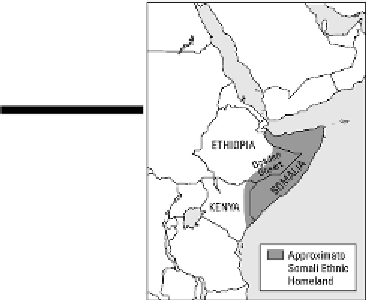Geography Reference
In-Depth Information
Multi-state nations
A
multi-state nation
consists of an ethnic group whose people and traditional homeland lies within
two or more countries. This situation may lead to
irredentism,
a foreign policy in which one country
seeks to acquire foreign territory for the purpose of unifying a nation. The term dates from the 1870s
when Garibaldi and his followers sought to incorporate “unredeemed”
(irredenta
) Italian-speaking
territories into the Italy that you see on today's map. The potential problem, of course, is that a coun-
try that contains the coveted land is not likely to give it up without a fight.
The Somalis provide a case study. This ethnic group's traditional homeland includes much of the
“horn” of East Africa (see Figure 14-4). In the latter part of the 19th century, Ethiopia, Italy, and
Britain signed a treaty that divided this region between them. Following de-colonization, the present
Somali Republic was established out of the territory controlled by Italy and Britain. But a large por-
tion of the traditional Somali homeland, known as the Ogaden, remains under Ethiopian control.
Figure 14-4:
The
horn region of
East Africa.
Somali politicians have argued that dividing up their traditional homeland among foreigners without
Somali consent was not fair in the first place; thus the Somali Republic rightfully ought to annex
Ogaden by any means necessary. Naturally, this argument echoes rather strongly among Somalis but
alarms Ethiopia, which views the Ogaden to be part of its territory by virtue of a legitimate treaty. The
result has been on-again, off-again debate and occasional armed conflict between the two countries
over control of the Ogaden.
State-less nations


